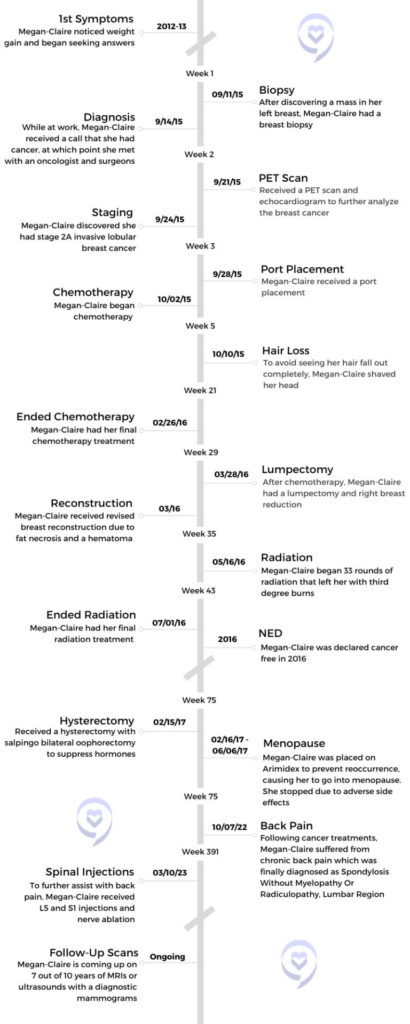Megan-Claire’s Stage 2A Invasive Lobular Breast Cancer Story
Megan-Claire C., Stage 2 Breast Cancer Diagnosis: Stage 2 Breast Cancer Symptoms: Green bruises, sudden weight gain, brittle hair, zit on breast, mass in breast Treatment: Chemotherapy, surgeries, radiotherapy, hormone therapies
Megan-Claire’s Stage 2A Invasive Lobular Breast Cancer Story
With ovarian and cervical cancer running in her family, as well as issues with her ovaries, Megan-Claire assumed she would get one of those cancers. Preventative early mammograms showed she was all-clear despite developing abnormal symptoms like green bruises, brittle hair, sudden weight gain, and a mass in her left breast. A biopsy revealed she had stage 2 invasive lobular breast cancer which doctors believed had been growing in her for 8-10 years.
As a single woman, Megan-Claire was unsure of how she would afford the cost of her cancer treatments when she came across the number for the social worker assigned to her case. This led to financial breakthroughs through grants her social worker directed her to. Still, being single with cancer led to other challenges such as being her own caretaker.
Megan-Claire shares her cancer story with us, including the challenges of finding good oncology care post-cancer, navigating the adverse side effects of cancer treatments, how she advocated for herself, how her quality of life changed, and her advice for others on their cancer journeys.

- Name: Megan-Claire C.
- Diagnosis (DX):
- Breast cancer
- Invasive lobular
- Left breast
- Breast cancer
- Staging: 2
- Symptoms:
- Green bruises on lower left leg and left arm
- Sudden weight gain
- Dry, brittle hair
- Zit on left breast
- Mass in left breast
- Age at DX: 39
- Treatment:
- Chemotherapy
- Red Devil
- Taxol
- Surgeries
- Quadrantectomy
- Reconstruction
- Fat necrosis and hematoma removal
- Hysterectomy and oophorectomy
- Radiotherapy
- Hormone Therapies
- Lupron
- Tamoxifen
- Nerve ablation and spinal injections for back pain
- ReBuilder for neuropathy
- Chemotherapy

Trust yourself and always remind them that [the doctors] are not the only ones making all the decisions. They can make suggestions for you, but it’s up to you to decide, is that the way I want to go?
Megan-Claire C.
This interview has been edited for clarity and length. This is not medical advice. Please consult with your healthcare provider for treatment decisions.
- Symptoms & Diagnosis
- Tell us about yourself
- Does cancer run in your family?
- What were your first symptoms?
- Being diagnosed with a rare form of breast cancer
- Did you suspect the mass was cancer?
- Getting a biopsy
- Getting a diagnosis
- How much time passed between you discovering the mass and getting a diagnosis?
- How did you process getting a cancer call?
- Treatments
- What were the next steps after getting diagnosed with breast cancer?
- What did the port feel like?
- How did cancer impact you financially?
- Speaking to a cancer social worker led to financial breakthroughs
- Did your doctors talk to you about preserving fertility?
- Taking classes to learn about the effects of chemo
- Is there still a ChemoFlage class people can take?
- What breast cancer treatments did you undergo?
- Side Effects
- Did you have side effects from cancer treatments?
- What caused your chemo-induced peripheral neuropathy?
- Did doctors inform you about adverse reactions to chemo that might occur?
- What does neuropathy feel like?
- What helped improve your neuropathy?
- Describe what it’s like using the ReBuilder for neuropathy
- Did you have any complications from your surgery?
- What was your experience with radiation like?
- The importance of being a patient advocate
- How did your body react to tamoxifen?
- Quality of Life
- Describe life after cancer
- Meeting others in the cancer community through Camp Hope
- Finding better medical care post-cancer
- Describe not being listened to by your doctor
- Finding medical care that’s best for you
- How did your body react to Lupron injections?
- Seeking new alternatives to prevent reoccurrence
- Describe your hysterectomy and oophorectomy
- How did you feel after that surgery?
- Were you working around the time of your surgery?
- Post-Cancer Complications
- What was the next course of action in your treatment?
- Did you feel relieved that you were in a position after surgery to not need follow-up medications?
- Did you eventually switch doctors?
- Further complications prompted more time off of work
- Were your finances affected during this time?
- Describe your fat necrosis surgery
- What led you to your current primary care provider?
- What helped your back pain?
- What has your quality of life been like with chronic pain?
- How long did you experience relief with spinal injections?
- Reflections
Symptoms & Diagnosis
Tell us about yourself
I am Megan-Claire Chase and Megan-Claire is my first name. I’m also known in the cancer space as Warrior Meg. I live right outside of Atlanta, Georgia, in Dunwoody. I get the best of both worlds because it’s right in the middle. I get the suburb feel and on the other side, I get the city feel because I like both.
I grew up in Macon, Georgia and my claim to fame there is that I was a former Cherry Blossom Princess. The whole court portrait hangs on Cherry Street in the Cherry Blossom House to celebrate the cherry blossom trees.




I went to college in upstate New York, the College of Saint Rose. The claim to fame there is Jimmy Fallon went there. I was a freshman when he was a junior, I believe, so I remember seeing him on campus.
I moved out to LA for 5.5 years, then I came back because my mother, who was also an ovarian cancer survivor, now has a rare blood cancer. As an only child of divorced parents, I was like, you only have one mother. So I moved back, but I had to be in Atlanta. I was like, I’m not going back to Macon. It’s a great place to be raised, but not to stay permanently. I also have a cat named Nathan Edgar, also known as Baby Natey. He appears in many things that I do and he will be 20 in August.
Does cancer run in your family?
My maternal grandmother, my Nana, told our entire family, “Know what’s normal for your body because we are all different” and “It’s your patient right to be pushy.”

I always start telling my story with, I always knew I would get cancer. I just knew it, but I thought it would be ovarian or cervical. It took my parents 8 years to get pregnant. They did multiple rounds of IVF and during that third month, my mother was diagnosed with ovarian cancer. That was traumatic and scary.
There was no scenario where both of us would survive and thrive. It was either one of us would die and one would live or both of us would die. It was very dire and she actually started hemorrhaging to death, which is why I was born 3 months early. I was supposed to be born in October. Instead, I was born July 3rd, which also happens to be my grandfather’s birthday. I was the favorite grandchild for a while because of that.

My maternal grandmother, my Nana, told our entire family, “Know what’s normal for your body because we are all different” and “It’s your patient right to be pushy.” She has said that forever, may God rest her soul.
Growing up, I had all of the same issues that my mother and my Nana did with my ovaries and I kept having abnormal pap smears. I really seemed to be on the path of one of those cancers. I got to have a preventative mammogram covered at the age of 35 because of that link between breast and ovarian.
I went and they told me, “You are clear. Come back when you’re 40.” I’m like okay, cool. Totally put it out of my head. They never went over the fact that I have dense breasts. My symptoms – and this is what really throws doctors for a loop – were very different than my white counterparts. That’s why I often tell people, especially those who are black and of color, that your symptoms may present differently. So it’s up to you to really push to make your doctors listen. That’s what happened to me.
What were your first symptoms?



I started gaining weight before that preventative mammogram. The weight just started rapidly happening. As someone who grew up studying theater and ballet, and was a cheerleader in college, I was fit. Then all of a sudden, this weight. I went to the doctors and they said, “You just need to lose weight and eat better.”
Now, these are all from chemo, these curls here. I never had curly hair, never wanted curly hair. My hair used to be straight and to my shoulders. I remember my stylist who had been doing my hair forever said, “Are you missing a nutrient? Because your hair is so dry and brittle.” Then it started falling out on the left side only. I’m like, What? I don’t know what is happening.
This is over about 2.5 years. I got these tiny green bruises on my lower left leg. Again, I am hyper-aware. I’m like, I don’t know what my body is trying to tell me here but this isn’t good. I kept going to the primary doctor and the endocrinologist. I thought maybe it was a thyroid thing. Blood tests kept coming back clear. [I was told], “You’re fine. You just need to lose weight and eat better. Maybe you should sleep a little bit more and get some rest.”
I’m like, okay, these are tiny, green bruises. I’m right-handed dominant. I’m trying to make it make sense and it’s not making sense. Then it gets even more peculiar. I get a circular-shaped, green bruise on the back of my left arm. By this point, my primary finally says, “I don’t know what your body’s trying to tell us.” It was just so peculiar. I’m so mad I didn’t think to get a picture of it at that time. But she said, “If this is still here in 2 weeks, I’m gonna bring a colleague in on this.”
Before 2 weeks was up, I went to the dermatologist because I was like, what is this on the outside of my left breast? She said, “Oh, that’s a zit.” I’m thinking to myself, that’s a very odd place for a zit to be on the outside of your left breast. I guess you’re getting where I’m going with all the left-side stuff. She gave me a cream and it didn’t hurt. It went away in 3 days so I thought, maybe she was right. But that just seemed odd to me.

I will never forget, it was August 31st, 2015. That morning when I’d taken a shower, I had not felt anything. But that night when I was taking a shower, I remember because I used to be a huge fan of the show Supergirl. It was in its first season and I was like, I’m going to get in my jammies. This is my show. I’m in the shower, and because of that weight gain and my breast getting bigger – because I never had big boobs before – I was always feeling them. And then I felt it and I was like, What? Where did this come from? It was on the side, it was as hard as a fist, and it was huge. I was like, what?
Being diagnosed with a rare form of breast cancer

As I started doing more research, I started to realize there’s a whole other underrepresented category. It’s hard enough that I’m a woman, a black woman, and now I’m a woman under 40 years old diagnosed with cancer.
Now we know that had been growing in me for probably 8 to 10 years and that it was missed on that mammogram due to the size of it. Ultimately, once I did get the cancer call, I was diagnosed with stage 2 invasive lobular breast cancer.
Lobular is rare in black women. It’s already an uncommon one. Only about 10 to 15% of women get lobular. It’s also known as the sneaky cancer because it can mask and look like healthy tissue, so a preventative mammogram doesn’t pick it up.
Did you suspect the mass was cancer?
I didn’t automatically think breast cancer or even cancer. I was like, what is this? Because of the feeling of it, because I am very aware of my body, and because my mother now has a rare blood cancer, I’m aware of certain things. I already knew it was a mass, so when I was told, “This is a mass. We need to have a biopsy.” I didn’t freak out because I was like, well, obviously. I also think I was protecting myself.
Getting a biopsy
I remember the biopsy. It happened to fall on 9/11/2015, a Friday. I was the last patient of the day and I just wanted to go home and not have to go back to work and think about it.
The doctor said, “I’m going to take about 8 to 10 tissue samples.” It sounds like a staple gun. To this day, I’m triggered when I hear a loud staple gun. She pulled almost 20 samples, I was counting. Because I’m an empath, I can sense when energy shifts in a room. Even though she kept her facial expression totally neutral, I knew she must have seen something. Why else are you taking 10 million samples? They told me, “We’ll get the results probably Tuesday or Wednesday of the next week.” I didn’t think anything else of it.
Getting a diagnosis

Lobular is rare in black women. It’s already an uncommon one. Only about 10 to 15% of women get lobular. It’s also known as the sneaky cancer because it can mask and look like healthy tissue, so a preventative mammogram doesn’t pick it up.
I went to work on Monday. At this time, I was working in radio on the sales side – wish it was behind the microphone. I was timing a commercial, so I’m always aware of the time. I said, “Man, I’m gonna have to send this back to the client. The commercial is too long.” My phone rang at 3:05 p.m. that Monday, and I almost didn’t answer it, because I didn’t know that number. But my gut was saying, answer the phone.

Because I’m a very dramatic person, I’m running down the hall to an empty conference room. This is back when I could run. Now I have neuropathy, I can’t really do that. And she says, “Megan-Claire, you have invasive lobular breast cancer. We don’t know the stage yet.” That was all. I said, “Invasive lobular breast cancer? What the heck is invasive lobular? Wait…Breast cancer. Cancer!” I started getting hysterical, but she snapped me back by being really calm. She said, “Megan-Claire, take a deep breath. I need you to go get a pen and paper because I have very important information to give you.”
Professionally, I do allow people to call me M.C. – short for Megan-Claire – because I really hate it when people chop off my name and just call me Megan. People asked, “M.C., are you all right? What’s going on?” I said, “Yeah, in a minute.”
I go back, and this is where I realize now I had a bit of privilege, which I didn’t recognize at the time. My primary doctor had already talked to the one that did the biopsy. They had already talked with each other and had gone over who were the top 2 oncologists they’d recommend for my case. Who’s the plastic surgeon they’d recommend for my case. I was given all that information upfront. I thought that was something that everyone’s doctors did for them, and it turns out they don’t. I realize now that was a gift.
I was diagnosed under 40, so that put me in the category of adolescent and young adult. Keep in mind, it was 2 months after my 39th birthday that I get this diagnosis, so I’m not feeling like a young adult. As I started doing more research, I started to realize there’s a whole other underrepresented category. It’s hard enough that I’m a woman, a black woman, and now I’m a woman under 40 years old diagnosed with cancer.
How much time passed between you discovering the mass and getting a diagnosis?
It was about a week and a half. Everything moved very quickly. Monday, I get the diagnosis. That Wednesday I met with the oncologist, that Thursday I met with the breast cancer surgeon, then that Friday I met with the plastic surgeon. It was like bam, bam, bam, bam, that whole week.
I remember thinking, why do I need a plastic surgeon? I wasn’t processing that I’m going to need some reconstruction at some point. None of it made sense.
How did you process getting a cancer call?

I really don’t like getting a cancer call. I honestly wish that they had said, “We need you to come in tomorrow. We’re making room for you and you need to bring someone. No if’s, and’s, or but’s about it.” You would already know this isn’t good, but I’ll have someone else with me who can drive and who’s a little bit more clear-headed. Instead of getting a call while you’re at work.
I did talk it over with my mother on the phone, but I didn’t want everyone at work to know this news. But it was so obvious that when I came back, I was in shock. I had gone pale. Everyone asked what happened, so it just came out. I didn’t want it to come out that way, but it’s because I got it while I was still at work and I didn’t know what to do. A coworker did drive me home because I couldn’t handle anything.
»MORE: Reacting to a Cancer Diagnosis
Treatments
What were the next steps after getting diagnosed with breast cancer?
Discovering I had to get 16 rounds of chemo. I did meet all the doctors and had all the tests then I had my port surgery. Before the port surgery, I hadn’t been under anesthesia since I was a kid. I don’t even remember the last time I was in an actual hospital.
My mother was all concerned for me. The nurse came out to go get her after getting the port inserted and my mother asked, “Is she okay?” She said, “She’s up there cracking jokes and laughing.” It really hit me as I think about it now how, even though I was feeling so miserable before the diagnosis and gained all that weight, I still had some energy left. I have none of that now and it’s harder for me to bounce back from a surgery.
What did the port feel like?
I distinctly remember getting that port and what it felt like to have something foreign inside my body. It felt heavy, it felt strange. The next day I was going to a luncheon for work with all the media companies in Atlanta, and I had this big old thing, and it was pretty darn obvious.
Everyone at that point knew I’d been diagnosed with cancer from the moment that I got the call. And getting all the tests and discovering I had to have 16 rounds of chemo.

How did cancer impact you financially?
I remember thinking, how am I going to pay for this? I’m single. I was not making a lot of money at the job I was in. Also, the health insurance wasn’t the greatest so I’m panicking like, how am I going to do this? Due to some technicality of when my insurance was renewed and when I got diagnosed, I was not eligible for short-term disability.
The person on the insurance side was so callous. She goes, “Well, you really should have thought to get this, to add this to your plan. It’s like a broken leg. You don’t know if you’re going to get a broken leg, but one day you will get a broken leg.” I said, “This is cancer.” I’ll never forget that. I thought to myself, wow. Is this how it is?
»MORE: Financial Toxicity of Cancer Treatment
Speaking to a cancer social worker led to financial breakthroughs

She was my social worker and she was a godsend because once I spoke with her and met with her, she helped me find grants to pay for my chemo and to pay for all those tests… When I tallied everything, all the costs of everything, it was almost $400,000 without insurance.
I’m naturally a very organized person because of my grandparent’s influence. My Nana at the time was a registered nurse. I’m glad she wasn’t alive to see me go through cancer because we were very, very close. My grandfather was a mortician, so they were the perfect couple. They always taught us to make sure you read everything, make sure you keep track of certain things. I just already knew to do that.
You’re given so much information when you get that diagnosis. It’s like paper here, paper there, this one’s yellow, this one’s pink, this one’s blue, here’s a book. I remember going through tons of paper where it was just all text, and I happened to see where it said, “Here is the social worker assigned to your oncologist.” I was like, “What is a social worker doing there?” That didn’t make sense to me. I still don’t understand that term in oncology, but I called it to find out.
Her name was Catherine. She was my social worker and she was a godsend because once I spoke with her and met with her, she helped me find grants to pay for my chemo and to pay for all those tests. What people don’t realize, it’s not just about the chemo, it’s all the other stuff as well. It’s every time you’re going to get your infusion, it’s all the medications that you get when you start having severe side effects. It’s the additional scans and all of this stuff all at the same time. I was able to get assistance for my rent because I was single.
If it wasn’t for her, I honestly don’t know what I would have done because I’ve heard of others where they’re just about to start chemo and then they discover that their insurance won’t authorize it. I thought to myself, oh my God, now I know why people die or why people sometimes have to file for bankruptcy and lose everything when someone gets critically ill. When I tallied everything, all the costs of everything, it was almost $400,000 without insurance.
Did your doctors talk to you about preserving fertility?

Once the port was








